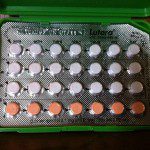
So last week I wrote about a very-statistically-credible German-conducted effectiveness study for sympto-thermal NFP that showed a user effectiveness rate of 98% for couples educated in a specific method. And I further said that the CDC claimed that NFP/FAM had a failure rate of 24%, but that I couldn’t find a source for that failure rate and didn’t give it much credence.
Now I’ve found the source: a study by the Guttmacher Institute that takes government survey data on contraceptive use and unplanned pregnancies and calculates “real world” failure rates. The linked study is from 2001, and it may have been updated in the meantime, but here are their conclusions: in the first year of use for women reporting “periodic abstinence” as a contraceptive method, 22.9% of women became unintentionally pregnant. This compares poorly, as you might imagine, to the 7.5% of unintentionally-pregnant pill users, and the 13.7% of condom users.
The study further calculates rates of unintentional pregnancy in the 2nd year of use, and here the rates drop for all methods, but they don’t move from these two calculations to some sort of overall effectiveness rate that’s identified as comparable to “effectiveness rates” that one generally sees. But this 23% — or whatever more recent figure there may be — is a potential source for the CDC’s 24% failure rate.
But here’s the catch: no where in the Guttmacher study is “periodic abstinence” defined, so I dug into the original source, the National Survey of Family Growth, and, in particular, their survey of contraceptive use. Here they don’t define the term, but they do split this out into two categories: “calendar rhythm” and “Natural Family Planning.” (The report doesn’t say whether women were asked to choose between these two categories, or whether the survey-takers asked for a free-response answer, then categorized it themselves.) And, out of the group of women ages 15 -44, 0.8% reported using “periodic abstinence.” The spit between these two subcategories? 0.7% reported “calendar rhythm” and 0.1% reported NFP.
That’s a shocker.
That says that any statistics on failure rates of “NFP” based on this study are useless, because the vast majority of women who are supposedly using the method, are doing nothing of the sort. No one* teaches “calendar rhythm,” and I can’t imagine that these “users” have really gone back to research Knaus-Ogino’s original method. Presumably these are women who have read that ovulation occurs on day 14, or maybe 14 days before your period, and are creating “rhythm methods” for themselves, rather than following any specifically defined and researched method.
(* I should clarify that almost no one teaches calendar rhythm, but that depends on whether the “Cycle Beads” method “counts” as such. This method, which is promoted generally for third world women, and has a researched user-effectiveness of 12%, with restrictions on use for women with cycles of 26 – 32 days, is based on counting days on a bracelet of sorts. But I doubt the 0.7% of women reporting “calendar rhythm” are following this method, which, so far as I understand, is largely promoted for women in third-world countries who would benefit from a very simplified method.)
So, readers, what do you make of this?
(Note: first published 11/26, edited for clarity 11/27)
image: from https://pixabay.com/en/calendar-year-calendar-office-dates-1255952/; public domain













